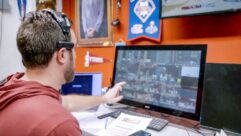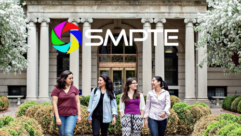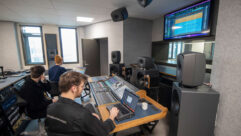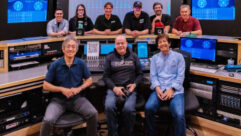Survey Says: College Students Want Podcasting
Sep 5, 2007 12:00 PM,
By Linda Seid Frembes
A recent survey released by D&M Professional, owner of Denon Professional and Marantz Professional brands, found that college students want podcasting technology, well, now. That comes as no surprise considering that, according to Pew Research, 84 percent of teenagers (ages 12-17) report owning at least one personal media device: a desktop or laptop computer, a cell phone, or a personal digital assistant (PDA). Forty-four percent of teens say they have two or more devices, while 12 percent have three and 2 percent report having all four of those types of devices. As these teens enter college, universities are being pushed to provide services that can use their features and turn them into teaching and learning devices.
Manufacturers such as D&M Professional are also tailoring their businesses to target market segments like higher education. Earlier this year, D&M Professional formed its Education Solutions Division (ESD), which aims to take a leadership role in the industry of educational podcasting and to act as a bridge between media technology and education. The ESD offers support for the podcasting, audio/video recording, and playback requirements of academic institutions. The D&M online portal, launched along with ESD, serves as a hub for information on market trends; information on audio and video recording products; technology solutions for classrooms, lecture halls, and auditoriums; and resources on such topics as podcasting, event recording, visual messaging, digital signage, archiving, content streaming, field recording, and distance learning.
It is D&M Professional’s ESD that sponsored the recent survey conducted by Market Position Research. The survey polled 12 private and public Midwestern universities and found that 88 percent of students surveyed indicated that they were extremely or very likely to use podcasting if offered to assist in their learning process. The study also found that currently, only 25 percent of universities surveyed were using recording equipment that supports podcasting technologies for downloading classes and lectures.
The survey data also confirmed that 90 percent of students who did listen to podcast lectures believed the audio recordings assisted them in the learning process, while 100 percent felt the use of podcasts had a positive impact on their overall grades. The students also indicated their attendance would not be affected if podcasts of classes and lectures were made available, but the materials would be used as a supplemental learning tool.
“The higher-education market is clearly ready for aggressive adoption of podcasting technologies,” says Peter Papageorge, director of sales for D&M Professional. “Students regularly use supporting equipment—iPods, other brands of MP3 players, PCs, laptops, and high-speed Internet. In addition, a majority of students in the study reported that their professors already post class and lecture notes online. We believe the adoption of regular professional recording of classes is the next logical step.” The survey also found that students who recorded classes using a personal recording device within the last 12 months were not happy with the quality of the recording, suggesting that a professional recording with higher-quality sound would be preferable.
According to Christina Tsonis, marketing manager for D&M Professional, the idea for the survey began to take shape several months ago. “We wanted to look into the specific needs and technologies of the higher-education market,” she says. “Based on feedback from our company’s Education Technology Advisory Council [ETAC], we noticed a trend. ETAC members, primarily AV managers from universities, noted that if they had research to bring to their school administrators about technology usage and wants, then it would help them to implement those systems in their schools.”
For systems integrators servicing the higher-education market, the results from this recent study can create an opportunity to approach new and current clients with the research. “It’s a good place to start the discussion,” Tsonis says. “The research can lend some validation to implementing podcasting technology.”
However, the biggest sales hurdle is that colleges and universities have disparate technology plans. Some institutions are very advanced while others are still installing basic classroom AV systems. Other roadblocks include raising the demand to a school’s administrative level, educating the faculty on how technology can benefit the curriculum, and finding equipment that is easy to use. “There are no norms; everybody in a different place in the process,” Tsonis says. “The good news is that most schools have AV managers in place. And from the student perspective, the classroom recordings don’t have to be both video and audio. A quality audio recording to use along with current notes and visuals is really what’s necessary.”










